
Catalog excerpts

SUPERIMPHY 625 is a nickel-based austenitic alloy containing chromium and molybdenum. The content of the latter elements provides SUPERIMPHY 625 with excellent corrosion-resistance in aqueous, acid and chloride environments as well as resistance to crevice corrosion. It is not susceptible to stress corrosion cracking. It also offers excellent resistance to high-temperature oxidation. Furthermore, depending on its metallurgical condition, SUPERIMPHY 625 has good creep-and fatigue-resistance. SUPERIMPHY 625 has outstanding mechanical and hardness properties from cryogenic temperatures through to 1100‘C. Best properties Mechanical properties Solution anneal (air-water) Therefore, due to its good corrosion-resistance and its mechanical properties, its typical fields of application are in the manufacture of components for service in seawater and all chloride solutions, as well as in phosphoric, nitric and sulphuric acid solutions... and also in the manufacture of components subjected to high temperatures. This alloy is therefore employed in numerous applications: shipbuilding, offshore, scrubbers, cryogenics, nuclear, aeronautics and chemical industries, transportation of corrosive products, pumps, compressors, fasteners. The table below gives this alloy’s nominal chemical composition by % weight:
Open the catalog to page 1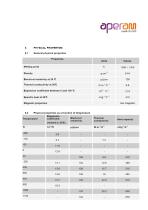
11.1 General physical properties Melting point Density Electrical resistivity at 20 'C Thermal conductivity at 20^ Expansion coefficient between 0 and 100 ■€ Specific heat at 20*0 Magnetic properties Physical properties as a function of temperature Expansion Electrical resistivity Thermal conductivity
Open the catalog to page 2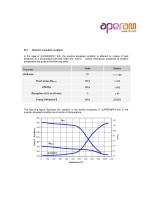
III.2 Solution annealed condition In the case of SUPERIMPHY 625, the solution annealed condition is attained by means of heat treatment at a temperature between 1090 and 1200“C. Typical mechanical properties at ambient temperature are given in the following table: The following figure illustrates the variation in the tensile properties of SUPERiMPHY 625 in the solution annealed condition as a function of temperature.
Open the catalog to page 4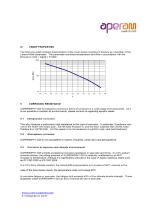
IV CREEP PROPERTIES The following graph enables determination of the mean stress resulting in fracture as a function of the Larson-Miller parameter. The parameter combines temperature and time in accordance with the formula X = [20 + log(t)] x T/1000. V CORROSION RESISTANCE SUPERIMPHY 625 is resistant to numerous forms of corrosion in a wide range of environments. As it is not possible to mention all environments, please consult us regarding specific cases. V.1 Intergranular corrosion This alloy features a particularly high resistance to this type of corrosion. In particular, it performs...
Open the catalog to page 5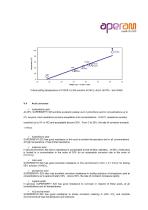
V.4 Acid corrosion * hydrochloric acid At 25*0, SUPERIMPHY 625 exhibits excellent resistan ce to hydrochloric acid in concentrations up to 5%, beyond which resistance remains acceptable at all concentrations. At 65‘C, resistance remains excellent up to 3% in HCI and acceptable beyond 30%. From 3 to 30%, the rate of corrosion exceeds 1 mtn/yr. s hydrofluoric acid SUPERIMPHY 625 has good resistance to this acid at ambient temperature and in all concentrations. At high temperature, it has limited resistance. S sulphuric acid In this environment, this alloy's resistance is comparable to that of...
Open the catalog to page 6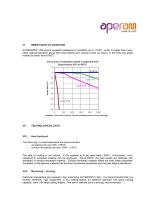
VI RESISTANCE TO OXIDATION SUPERIMPHY 625 enjoys excellent resistance to oxidation up to 1100‘C, which is higher than many other high-temperature alloys following heating and cooling cycles as shown in the following graph relating to mass loss at 98213. mass loss of stainless steels compared with Superimphy 625 at 982^ VII.1 Heat treatment The following two heat treatments are recommended: - annealing between 930 -10500 - solution annealing between 1090 -12000 The rate of cooling is not critical. If the material is to be used below 6500, hot-finished, work-hardened or annealed material can...
Open the catalog to page 7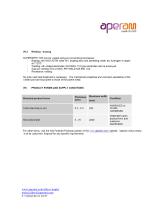
SUPERIMPHY 625 can be welded using all conventional processes: - Brazing with AWS ASTM class Ni-1 brazing alloy and annealing under dry hydrogen or argon at 1120*0 - Welding with coated electrodes: INCONEL 112 type electrodes can be employed. - Gas arc welding (TIG or MIG): PHYWELD 625 filler wire - Resistance welding No post-weld heat treatment is necessary. The mechanical properties and corrosion-resistance of the welded joint are equivalent to those of the parent metal. VIII PRODUCT FORMS AND SUPPLY CONDITIONS For other forms, visit the Hot Finished Products section of the www.aperam.com...
Open the catalog to page 8All APERAM ALLOYS IMPHY catalogs and technical brochures
-
AFK® 18
1 Pages
-
AFK® 1
1 Pages
-
SY 718
2 Pages
-
NICRIMPHY 600
1 Pages
-
Welding Alloys Wire Rods
2 Pages










